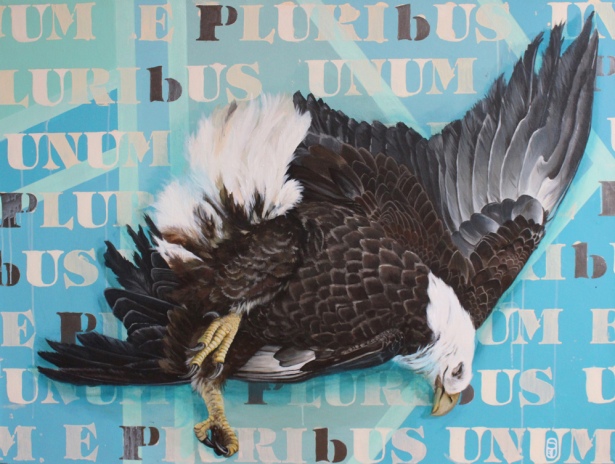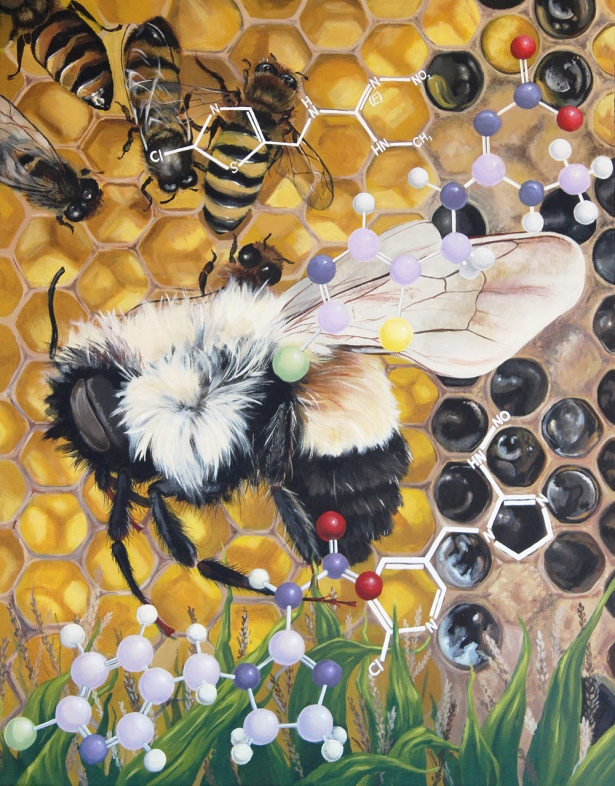This post comes from the Artists and Climate Change Blog
When I was small, like most kids I loved to draw and was obsessed with animals. But as I grew up, my fascination never went away. I instinctively knew that art had to be an integral part of my life. I applied to schools and was lucky enough to be accepted into a prestigious college where I spent my first year immersed in foundation studies — drawing, painting, and sculpture. At the beginning of my second year, the time came to choose a major. Without giving it too much thought, I and the majority of my class chose illustration.
And so I began my artistic education in earnest. I learned to accurately represent people, places, and things on paper. I learned to boil down the concept of a magazine article or book and draw it in one frame. I learned pen and ink, watercolors, acrylic, and oil painting. I learned how to work with clients who needed to sell a product or an idea quickly and effectively. My work was not deemed successful unless the message and intent were easily gleaned in three seconds or less. Although I am grateful for the education I received, the career path this training led me to ultimately left me deeply unfulfilled.
Not wanting to live an unsatisfying life, I tried to figure out the reason for my discontent. It seems obvious now, but it took me about eight years to find that what I was missing was the ability to be regenerative to self and society. The concept of creating easily-digested images felt like I was fueling the capitalist machine and reinforcing our ever-shortening attention span. The more I researched, the more I realized I was not alone. Even the college that I went to, Rhode Island School of Design, now offers an MA in Nature-Culture-Sustainability Studies. The burgeoning fields of social practice and interdisciplinary art indicate to me that there is a whole generation of dissatisfied artists looking for ways to use their skills to find solutions to some of the world’s most pressing problems.
I chose to radically change the course of my artistic practice when I enrolled in an Interdisciplinary Master of Fine Arts program at the University of Hartford. I sometimes find it hard to believe that both this program and my course in illustration fall into the same category of “art.†The artists that I have been introduced to in the last year, such as Mark Dion, Hope Ginsburg, Ernesto Pujol, and Linda Weintraub, have reminded me how art can be a powerful tool for social change, not just another trade to further the destructive goals of capitalism.
Through these and other artists, I have discovered the importance of making open-ended and sometimes ambiguous art. They have demonstrated why making work that requires contemplation and interpretation is so important in today’s fast-paced world. Slowly, I am learning to let go of the control over my own work that I cultivated for years as an illustrator.
Why is it so important to release control over your message? I have asked myself this many times over the past year. As a trained illustrator, it seems so fundamental that the point of art is to communicate. I still believe this to be true, but my understanding of the word “communicate†has evolved. An illustration conveys the client or illustrator’s point of view. It supports a campaign, article, or written piece. If it is successful, an illustration evokes the same response in most, if not all, viewers. The viewer understands that this is what they are meant to think or feel, and they move on. This happens to each one of us hundreds of times a day as we are bombarded with all forms of media. I believe it creates a numbing effect that cancels out the very intention of the work. Instead of feeling a certain way about an idea, we get so overwhelmed that we feel nothing at all. Apathy becomes a coping mechanism for most people just to survive the day.
When we create work that requires interpretation, we ask the viewer to stop, think, and most importantly, engage. Although we may not reach everyone, those who accept the challenge and create their own narrative begin to feel agency over the work. It becomes a collaboration through the mere act of a viewer’s engagement and interpretation. This connection is important because those who feel agency can begin to feel empowered to engender change on their own. It opens up dialogues that would not have occurred if everyone agreed on the subject and intention of a given work of art.
With many of my most recent paintings, I begin as an illustrator would with a specific story or idea in my mind. My painting E Pluribus Unum (2017) was conceived of when I read an article about the Trump administration’s decision to reverse the ban on lead bullets for hunting on federal grounds. This decision has led to thousands of raptors, including bald eagles, to die of lead poisoning in the wild. When I show the painting, I have rich and deep discussions with viewers because they see different things depending on their own experiences. Some latch onto the imagery, some to the text, others just to the colors and textures. Through this one piece, I have been able to discuss environmentalism, public policy, Greek mythology, race relations in America, the gun debate, and so much more. Although much of what has been brought up was not my original intention, I still feel a sense of satisfaction and success that I have never felt with an illustration, precisely because of these conversations.
Art in its myriad forms has many levels of power. It is often used as a tool for propaganda, but I believe its most potent use is to connect people through dialogue. I still use the skills I learned as an illustrator to point the conversation in a particular direction, but I no longer see any value in choreographing the conclusion to that conversation as well.
______________________________
Sophy Tuttle is an artist from Boston, Massachusetts whose work reflects her interest in politics and the environment. She received her BFA in Illustration from Rhode Island School of Design and is currently working on an MFA in Interdisciplinary Art from the University of Hartford Art School. Her work has been shown extensively in New England, as well as nationally and internationally. Influenced by artists such as Walton Ford, Mark Dion, Alexis Rockman, and J. J. Audubon, her work calls attention to the environmental consequences of humankind’s collective values and decision-making in the Anthropocene era.Â
Artists and Climate Change is a blog that tracks artistic responses from all disciplines to the problem of climate change. It is both a study about what is being done, and a resource for anyone interested in the subject. Art has the power to reframe the conversation about our environmental crisis so it is inclusive, constructive, and conducive to action. Art can, and should, shape our values and behavior so we are better equipped to face the formidable challenge in front of us.





